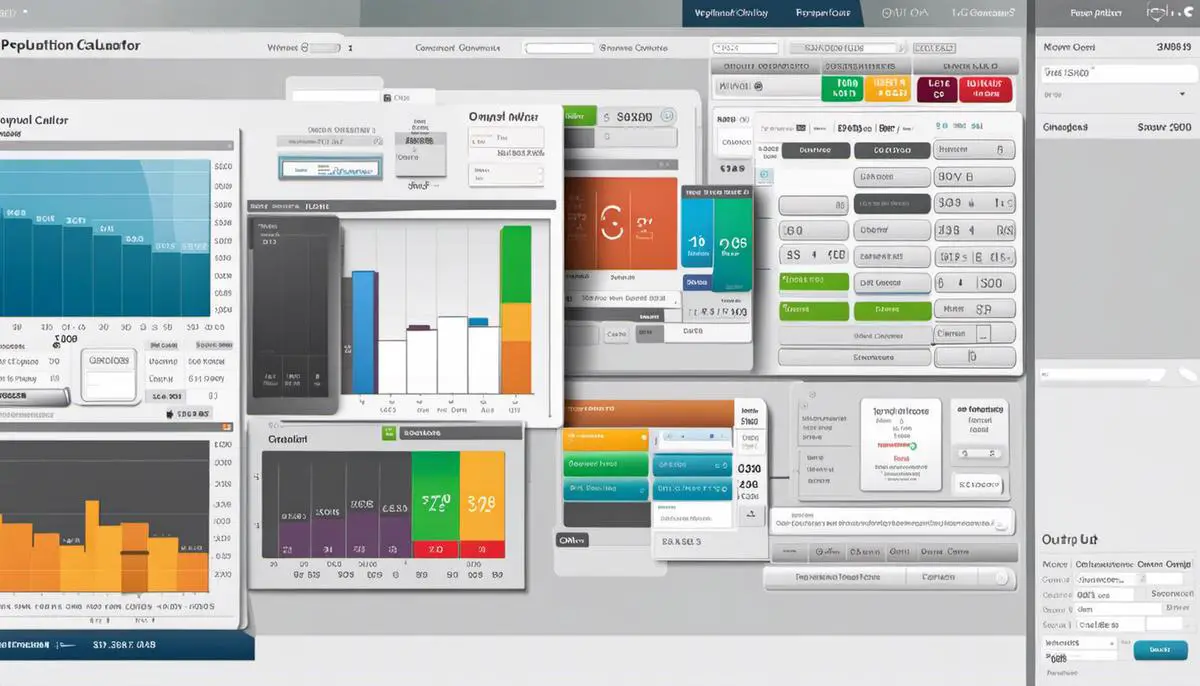Demographics play an integral role in all aspects of life, from business and economics to social sciences and urban planning. Their impact is so vast and integral, understanding their calculation is of utmost importance not just for experts but also for the general public. This all starts with the basics: population size, birth and death rates, immigration and emigration. Beyond these, mathematical principles form the basis for accurately calculating and predicting population trends. Equally essential are practical tools such as population calculator programs, which make these complex calculations manageable and easy to understand.
Understanding basic demographics
Demographic Data: Understanding the Basics
Demographic data refers to statistical information about a specific group of people or population. It involves many variables including population size, birth rate, death rate, immigration rate, and emigration rate. Population size refers to the total number of individuals present in a specific geographic area. The size of a population can change over time due to multiple factors like births, deaths, immigration, and emigration.
Birth and Death Rates: The Natural Increase
The birth rate refers to the number of live births per 1,000 individuals in a population within a year. Comparatively, the death rate points to the number of deaths per 1,000 individuals in a population within the same year. When the birth rate exceeds the death rate, it leads to a natural increase in population. Conversely, if the death rate exceeds the birth rate, it leads to a natural decrease.
Understanding Immigration and Emigration Rates
Immigration rate represents the number of individuals moving into a region, while the emigration rate refers to the number of individuals moving out of a region. Both of these rates are usually calculated per 1,000 individuals in a population within a year. When the immigration rate exceeds the emigration rate, the population increases and vice versa.
Taking Into Account All Variables
Calculating the population involves considering all these variables. A simple formula to understand total population change is:
Population change = (Births + Immigration) – (Deaths + Emigration)
It’s important to know these variables as they are not only instrumental in determining the population size, but they also provide insight into the demographic profile of regions. They can reveal trends about societal health, economic development, and even political stability. Hence, understanding basic demographics helps us make sense of the complex societal structures we live in.
A Look at Different Scenarios
For example, a low birthrate coupled with a high death rate might indicate an aging population, which might further dictate potential policy changes like pensions and healthcare. Similarly, high immigration rates can point to economic opportunities attracting outside individuals, while high emigration rates might suggest social or economic instability compelling individuals to leave.
In the end, each demographic data point adds a valuable piece to the jigsaw puzzle of a population’s reality, lending itself to critical interpretation and decision-making for individuals, communities, and governments alike.

Mathematical Principles for Population Calculation
Understanding the Concept of Population
Population refers to the total number of individuals residing in a specific geographical area at a given period. This could be small communities, towns, cities, regions, or the entire global population. Understanding how to calculate and predict the population is essential, especially for city planning, resource allocation, and demographic studies.
Basic Mathematical Principles in Population Calculation
The calculation of population usually requires considering two primary factors: the existing population (P) and the rate of natural increase or decrease (r). The natural increase or decrease, expressed as a percentage, includes births and deaths but does not account for migration.
The formula for calculating the future population (FP) considering these factors is:
FP = P * (1 + r/100)^n
Here, ‘n’ refers to the timespan in years for which the calculation is being done.
Deciphering the Population Calculation Formula
Breaking down the formula, ‘P’ denotes the present population. You add the rate of natural increase (r), divided by 100 to convert it into a decimal equivalent to 1, and raise the sum to the power equivalent to the number of years (n) you want to calculate for.
For instance, if we have a city with a population of 50,000 people (P), and the rate of natural increase is 2% (r), to find out the population in 10 years (n), the calculation would be:
FP = 50,000 * (1 + 2/100)^10
This equation will provide an estimate of the population after the specified period.
Importance of Data Accuracy
While the formula seems simple, it is crucial to understand that the accuracy of predictions heavily depends on the quality of data used. This mathematical model assumes that the rate of increase or decrease will remain constant — an assumption that may not always hold true.
Considering Migration in Population Calculations
In many geographic areas, migration patterns significantly impact the population. If migratory patterns are consistent, we can incorporate them into the formula. Often, net migration (immigration – emigration) is considered. If net migration is positive (i.e., more people are coming than leaving), it can be added to the rate ‘r’.
Understanding Variations in Population Calculation
Different regions use different methods for population calculation and projections. Some sophisticated models consider factors like age demographics, fertility rates, mortality rates, and other societal variables. These models tend to produce more accurate predictions but are somewhat more challenging to use. For general purposes and a quick estimation, the simple formula initially provided will suffice.

Use of Population Calculator Programs
Understanding Population Calculator Programs
Population calculators are digital tools designed to make predictions about future populations based on certain inputted variables. Software like PopTools, Population Pyramid, and PopEd are some of the widely-used population calculators available on the internet. These tools can generate fast and accurate calculations to help social scientists, policymakers, and students to make informed decisions.
Selecting a Population Calculator
Select the ideal calculator based on your needs. For a simple calculator, Population Pyramid will suffice. If you need more advanced analysis, consider using PopTools, a plugin for Excel, or a dedicated program like PopEd.
Operating the Population Calculator
Navigating a population calculator involves inputting necessary data into designated fields within the program. The required data may include current population size, birth rates, death rates, migration rates, or other relevant factors. These rates can be obtained from government census data or reputable statistical sources.
Data Input for Population Calculators
Enter the required data into the appropriate sections of the online form or software interface. While the exact labels will vary depending on the calculator, the general format usually includes a place for initial population figures and predicted changes in various demographic attributes (like age, gender, education level, etc.).
For example, in PopTools, users can input the current population, projected growth rate, and other relevant numbers into an Excel sheet within the software. Similarly, in Population Pyramid, users will enter country-specific information for the program to generate a graphic of population distribution.
Interpreting Population Projections
Take the time to understand the output provided by the population calculator. The results may be presented in tabular, graphical, or narrative form depending on the complexity of the software and the inputted variables.
For instance, in the case of Population Pyramid, an output graphic might display males on the left, females on the right, with age groups shown vertically. PopTools provides output in the form of detailed Excel spreadsheets that can be customized to the user’s needs.
Scenario Experimentation
Experiment with different scenarios to gain various perspectives. In the context of a population calculator, changing variables such as fertility rates, immigration rates or life expectancy can dramatically alter the population predictions. This allows users to understand how different factors might influence future demographic trends.
Remember, the accuracy of these predictions is dependent on the accuracy of the inputted data. Therefore, always ensure to use the most up-to-date and accurate data to get the most reliable results.

Application of Population Calculation
Understanding Population Calculation Basics
Population calculation involves estimating or counting the number of individuals in a particular group or area. This can involve people residing in a city, students enrolled in a university, or even members of a certain species in an environment. To do this, you may need to use various statistical techniques and tools, such as data from previous years, growth rates, and ratios.
Applying Population Calculation in Business
Successful business planning heavily relies on accurate population calculation. Businesses need to understand the size and characteristics of their target audience in order to effectively market their products or services. For instance, a clothing retailer targeting young adults would need to know the number of young adults in their area in order to accurately plan their inventory needs and advertising strategies. To achieve this, you can use publicly available data such as census reports or conduct your own surveys.
Population Forecasting in Economics & Urban Planning
Population calculation also plays a crucial role in economics and urban planning. Economic forecast models often use population size and growth trends to project future market conditions and labor force trends. In urban planning, accurate population calculations can help in the designing of infrastructure, such as predicting future traffic patterns or planning the number of needed public amenities like hospitals, schools, or parks.
Implication for Social Sciences
In social sciences, research often involves population calculation. Sociologists, psychologists, and demographers use population calculation to gather and analyze data about societal trends, including migration patterns, birth rates, death rates, and other demographic changes. This helps in policy planning and formulation at both local and national levels.
Population Calculation for Budget Analysis
Organizations and institutions use population calculation for budget analysis. You can determine the per capita spending by dividing the total budget by the total population. This aids in understanding how much of the budget is spent on each person on average, which can be helpful in identifying spending inefficiencies or areas that may require more investment. Ensuring effective distribution of resources is one key reason why accurately calculating population is critical.
Annual Growth Rate Calculation for Long-Term Planning
For long-term planning, you might also need to calculate the annual growth rate of a population. This can be done by subtracting the population number of the previous year from the current year, then dividing the result by the population number of the previous year and multiplying the result by 100. This will give the percentage of how much your population has grown or shrunk in one year. Combining this information with other economic indicators can paint a clearer picture of the future, providing valuable insights for long-term planning.
Using Population Density in Planning
Understanding population density, or the number of people per unit area, is crucial for planning in many fields. From urban development to public health planning, knowing how densely populated an area is can affect decisions significantly. For example, in urban planning, areas with higher population densities may need more public parks or transportation options. In public health, higher population densities might indicate areas at higher risk of infectious disease spread.
In conclusion
Population calculation is a fundamental concept that applies to numerous real-life fields. Mastering it enables better planning, forecasting, and effective decision-making processes, all of which are crucial for development and growth.

Applying population calculations is where the real learning happens. It is where all the principles, tools, and discussions weave into one practical, understandable concept. In real life scenarios, these calculations are used to plan, forecast, and execute budget analysis in various fields. Whether for a businessman daunting over population metrics for planning, a social scientist contemplating population growth effects, or an urban planner designing cities for future generations, the importance of population calculations cannot be overstressed. So, as we continue to etch into this millennia, let’s take the knowledge we’ve explored and put it to good use, for ourselves and future generations.






